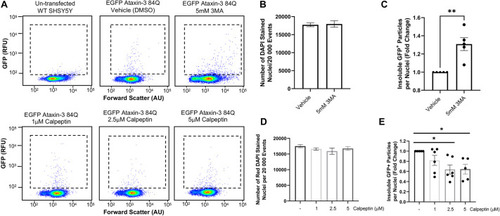- Title
-
Flow cytometry allows rapid detection of protein aggregates in cellular and zebrafish models of spinocerebellar ataxia 3
- Authors
- Robinson, K.J., Tym, M.C., Hogan, A., Watchon, M., Yuan, K.C., Plenderleith, S.K., Don, E.K., Laird, A.S.
- Source
- Full text @ Dis. Model. Mech.
|
Neuronal-like SHSY5Y cells develop EGFP ataxin-3 protein aggregates. (A) SHSY5Y cells transiently expressing EGFP-fused human ataxin-3 (28Q and 84Q) develop protein aggregates. White arrowheads indicate EGFP-fused ataxin-3 protein aggregates. (B) The mean number of aggregates per transfected cell was calculated by averaging six experimental replicates (different fields of view) per coverslip. Aggregates were more commonly observed in cells transfected with the EGFP ataxin-3 84Q repeat expansion than cells transfected with EGFP ataxin-3 28Q repeat expansion. (C) Quantification of the percentage of cells harbouring protein aggregates revealed significantly more cells were affected by protein aggregates following transient transfection with EGFP ataxin-3 84Q compared to EGFP ataxin-3 28Q or EGFP only. (D) Western blotting was used to examine the expression of ataxin-3 following transient transfection of EGFP constructs. (E) Expression of EGFP-fused ataxin-3 was significantly higher in cells transfected with EGFP only or EGFP ataxin-3 84Q. Data are mean±s.e.m. n=4-5 experimental replicates. *P<0.05; **P<0.01; ***P<0.001; ****P<0.0001; ns, not significant (one-way ANOVA with Tukey's post-hoc test). |
|
Flow cytometry can be used to quantify the number of detergent-insoluble EGFP ataxin-3 particles relative to the number of nuclei. (A) Representative flow cytometry scatterplots displaying UV+ nuclei and EGFP-fused ataxin-3 particles from cell lysates. (B) Quantification of the number of DAPI+ nuclei revealed that similar numbers of nuclei were present in the analysed samples. (C) Cells expressing EGFP-fused mutant ataxin-3 (84 glutamines) developed significantly more insoluble particles compared to EGFP alone or EGFP-fused ataxin-3 with a short polyglutamine stretch (28 glutamines). (D) Detergent-insoluble particle size did not significantly differ across the examined genotypes. Data are mean±s.e.m. n=4-9 experimental replicates. *P<0.05; **P<0.01; ns, not significant (one-way ANOVA with Tukey's post-hoc test). AU, arbitrary units; RFU, relative fluorescence units. |
|
Treatment with autophagy pathway modulators altered the number of EGFP-fused particles present in cells expressing human ataxin-3 with 84 glutamines. (A) Representative scatterplots reveal a scarcity of EGFP-fused particles in untransfected control cells and altered numbers of particles following treatment with autophagy modulators (3MA and calpeptin). (B) Quantification of the number of DAPI+ nuclei revealed that a similar number of nuclei were present across vehicle-treated and 3MA-treated samples. (C) Comparison of cells treated with vehicle or 3MA (5 mM) revealed a statistically significant increase in detergent-insoluble particles relative to the number of nuclei following 3MA treatment. (D) Similar numbers of nuclei were quantified in samples treated with a vehicle control or calpeptin. (E) Calpeptin treatment produced reductions in detergent-insoluble particles, as detected by FloIT. Data are mean±s.e.m. n=2-6 experimental replicates. *P<0.05, **P<0.01 (one-way ANOVA with Tukey's post-hoc test or Student's t-test, paired, two-tailed). AU, arbitrary units; RFU, relative fluorescence units. |
|
Transgenic zebrafish expressing human ataxin-3 with 84 glutamines develop ataxin-3+ protein aggregates. (A) Confocal microscopy was performed on 6-day-old zebrafish larvae expressing EGFP-tagged human ataxin-3 containing a short polyglutamine stretch (28Q) or long polyglutamine stretch (84Q). (B) Manual counting of EGFP aggregates revealed that significantly more aggregates were present in 6-dpf zebrafish expressing EGFP ataxin-3 84Q than those expressing EGFP ataxin-3 23Q. (C) Quantification of the percentage of cells harbouring protein aggregates revealed that a greater number of cells were affected with aggregates in zebrafish expressing EGFP ataxin-3 84Q. (D) Measurement of the size of protein aggregates observed via confocal microscopy revealed that zebrafish expressing EGFP ataxin-3 84Q also display aggregates that are significantly larger in size compared to the aggregates found in zebrafish expressing EGFP ataxin-3 23Q. (E) Western blotting was used to examine the relative expression of human ataxin-3 across the examined genotypes. (F) Densiometric analysis revealed significantly greater expression of EGFP-fused human ataxin-3 in transgenic zebrafish compared to non-transgenic siblings. Data are mean±s.e.m. *P<0.05; **P<0.01; ***P<0.001; ****P<0.0001; ns, not significant (one-way ANOVA with Tukey's post-hoc test or Student's t-test, paired, two-tailed). n=4-5 experimental replicates. EXPRESSION / LABELING:
|
|
Flow cytometric analysis of dissociated cells from whole zebrafish can be used to rapidly quantify insoluble EGFP ataxin-3 particles and screen compounds for the effect on proteinopathy. (A) Representative scatterplots of flow cytometric populations from dissociated 6-day-old zebrafish revealed changes in the number of detected detergent-insoluble particles despite similar numbers of nuclei. (B,C) Zebrafish expressing human mutant ataxin-3 displayed similar numbers of RedDot-stained nuclei but significantly more detergent-insoluble ataxin-3 particles at 2 days of age. (D) Examination of insoluble particle size revealed similar-sized particles across genotypes. (E,F) At 6 dpf, cells from dissociated zebrafish showed similar numbers of nuclei but more EGFP ataxin-3 particles were detected in cells obtained from zebrafish expressing human mutant ataxin-3 compared to non-transgenic siblings and zebrafish larvae expressing human wild-type ataxin-3. (G) Detergent-insoluble particles were a similar size in cells obtained from zebrafish expressing wild-type human ataxin-3 and mutant human ataxin-3. (H) Treatment with the autophagy inhibitor chloroquine (3 mM) increased the number of detergent-insoluble particles detected. (I) Treatment with the autophagy inducer calpeptin decreased the number of detergent-insoluble particles in 2-dpf zebrafish expressing mutant ataxin-3. Data are mean±s.e.m. n=2-9 experimental replicates. *P<0.05; **P<0.01; ***P<0.001; ns, not significant (one-way ANOVA with Tukey's post-hoc test or Student's t-test, paired, two-tailed). AU, arbitrary units; RFU, relative fluorescence units. |
|
Flow cytometric analysis of cells dissociated from zebrafish larvae can be a powerful addition to high-throughput drug screening pipelines, revealing cellular level insights. |






